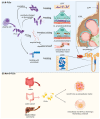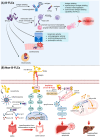B Cell-Derived and Non-B Cell-Derived Free Light Chains: From Generation to Biological and Pathophysiological Roles
- PMID: 40806736
- PMCID: PMC12347604
- DOI: 10.3390/ijms26157607
B Cell-Derived and Non-B Cell-Derived Free Light Chains: From Generation to Biological and Pathophysiological Roles
Abstract
Immunoglobulin light chains are essential components of intact immunoglobulins, traditionally believed to be produced exclusively by B cells. Physiologically, excess light chains not assembled into intact antibodies exist as free light chains (FLCs). Increasingly recognized as important biomarkers for diseases such as multiple myeloma, systemic amyloidosis, and light chain-related renal injuries, FLCs have also been shown in recent decades to originate from non-B cell sources, including epithelial and carcinoma cells. This review primarily focuses on novel non-B cell-derived FLCs, which challenge the conventional paradigms. It systematically compares B cell-derived and non-B cell-derived FLCs, analyzing differences in genetic features, physicochemical properties, and functional roles in both health and disease. By elucidating the distinctions and similarities in their nature as immune regulators and disease mediators, we highlight the significant clinical potential of FLCs, particularly non-B cell-derived FLCs, for novel diagnostic and therapeutic strategies.
Keywords: Igκ; Igλ; free light chain; immunoglobulin; non-B cell.
Conflict of interest statement
The authors declare no conflicts of interest.
Figures



Similar articles
-
Prescription of Controlled Substances: Benefits and Risks.2025 Jul 6. In: StatPearls [Internet]. Treasure Island (FL): StatPearls Publishing; 2025 Jan–. 2025 Jul 6. In: StatPearls [Internet]. Treasure Island (FL): StatPearls Publishing; 2025 Jan–. PMID: 30726003 Free Books & Documents.
-
Systemic treatments for metastatic cutaneous melanoma.Cochrane Database Syst Rev. 2018 Feb 6;2(2):CD011123. doi: 10.1002/14651858.CD011123.pub2. Cochrane Database Syst Rev. 2018. PMID: 29405038 Free PMC article.
-
Short-Term Memory Impairment.2024 Jun 8. In: StatPearls [Internet]. Treasure Island (FL): StatPearls Publishing; 2025 Jan–. 2024 Jun 8. In: StatPearls [Internet]. Treasure Island (FL): StatPearls Publishing; 2025 Jan–. PMID: 31424720 Free Books & Documents.
-
Uncommon Non-MS Demyelinating Disorders of the Central Nervous System.Curr Neurol Neurosci Rep. 2025 Jul 1;25(1):45. doi: 10.1007/s11910-025-01432-8. Curr Neurol Neurosci Rep. 2025. PMID: 40591029 Review.
-
Management of urinary stones by experts in stone disease (ESD 2025).Arch Ital Urol Androl. 2025 Jun 30;97(2):14085. doi: 10.4081/aiua.2025.14085. Epub 2025 Jun 30. Arch Ital Urol Androl. 2025. PMID: 40583613 Review.
References
-
- Huang J., Zhang J., Zhang L., Wang Z., Fan T., Yin S. The Structure Characteristics and Function of Non B Cell-Derived Immunoglobulin. In: Qiu X., Huang J., Xu X., editors. Non B Cell-Derived Immunoglobulins: The Structure, Characteristics and the Implication on Clinical Medicine. Springer Nature; Singapore: 2024. pp. 59–71. - PubMed
-
- Boivin D., Provençal M., Gendron S., Ratel D., Demeule M., Gingras D., Béliveau R. Purification and Characterization of a Stimulator of Plasmin Generation from the Antiangiogenic Agent Neovastat: Identification as Immunoglobulin Kappa Light Chain. Arch. Biochem. Biophys. 2004;431:197–206. doi: 10.1016/j.abb.2004.08.022. - DOI - PubMed
Publication types
Grants and funding
LinkOut - more resources
Full Text Sources

